| 
ET components:
back - Vac-formed nose and fiberglass (Jay Marsh) main tube
center - Removeable Engine mount assembly
front - Aft bulkhead, vac-formed aft dome, Intertank bulkhead | 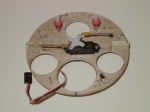
Intertank Bulkhead:
Servo in center drives SRB attachment latches. Hole near top/back is for engine mount assembly, threaded nylon bolts and cast red thumbnuts help secure removeable engine mount assembly. Holes near front are lightening holes and provide good access and views inside of main ET. | 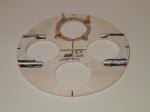
Aft Bulkhead:
Hole near top/back is for lower portion of removeable engine mount assembly. Four wedges help to guide the engine mount into place. To left and right are four pieces of 5/32" aluminum tubing, into which the 1/8" diameter SRB aft attachment rods will be secured. |
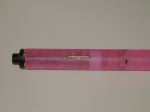
Removeable Engine Mount:
Engine is free to slide 1/8" against a thrust sensor assembly. Fiberglass tube by Ross Hironaka | 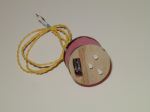
Thrust Sensor:
Small Lever switch as sensor. Pen springs mounted inside to help push engine back after thrust drops too low, via 3/32" plastic tubing. | 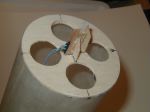
Liftoff Sensor:
Small Lever switch mounted in housing so that 1/8" rod presses onto switch. Seen here glued to aft bulkhead and main ET tube.
|
| 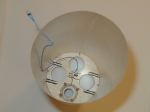
Aft Bulkhead after gluing to ET. Also seen is liftoff sensor lead wiring. | 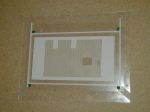
Intertank wrap mold step 1:
Half-Pattern (180 degrees) laser-cut by Tom Campbell is carefully laid atop laminating film that is adhesive-side-up (entire set-up is laid atop glass plate, in this case from an 8 x 10 picture frame). Strips of plastic laid along the edges, with clay in corners, to act as mold box for pouring the RTV mold. | 
Intertank wrap mold step 2:
Carefully brushing RTV into the nooks and crannies of the pattern, careful to prevent voids and air bubbles. |
| 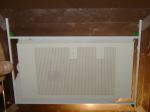
Intertank wrap mold step 3:
Hold the mold pattern up against ceiling light to look thru to try to spot any voids or bubbles.
BTW - This 180 degree wrap is for the -Z, or non-orbiter, side of the Intertank | 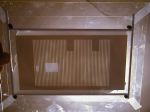
Intertank wrap mold step 4:
Same as step 3, photo without flash to show the light coming thru. Do NOT pour the rest of the RTV into mold until sure there are no voids or bubbles from the brush-on steps.
| 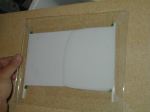
Intertank wrap mold step 5:
After carefully pouring the remainder of the RTV, and allowing several minutes for any air bubbles to come to the surface and pop, place a glass sheet down over ONE END of the RTV, laying down the rest of the glass sheet like a hinge. Do it slowly, so that the excess RTV is squeezed to one side. This helps to avoid trapping air bubbles which would be likely if the glass sheet were simply applied "flat". Apply a weight and allow RTV mold time to fully cure. Sorry, no pics of the cast wraps being made.
|
| 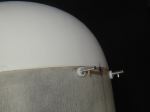
ET SRB aft Attach Rods:
1/8" Aluminum rods were machined with half-shaft ends (by Bob Biedron) and 1/32" holes drilled thru to attach 1/32" brass pins. The 1/8" rods were mounted inside of the 5/32" aluminum tubing glued to the aft dome, thin CA was used to secure the 1/8" rods inside the tubing. | 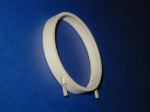
SRB Aft Attach Ring:
Cast ring has 1/32" music wire reinforcement inside of the struts to make them less fragile. 3/64" holes in the half-shaft portions engage the 1/32" pins of the ET SRB attach struts. | 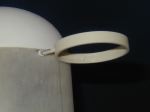
ET and SRB Ring attached:
SRB aft attach ring shown without SRB, for clarity of operation. Note how the half-shaft portions of the struts fit with each other. |
| 
SRB Aft Ring Detaching:
When SRB nose is released, SRB pivots outwards until half-shaft holes in SRB ring no longer engage the pins in the ET half-shafts, allowing SRB to fully separate.
| 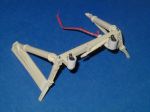
ET & Orbiter Aft Attach Struts:
Assembly shown with two micro-lever switches (black) that detect orbiter sep. Wired in series such that both have to sense orbiter sep. Also notable are 1/16" brass pins that the Orbiter attaches to. They carry the acceleration loads from the ET to the orbiter.
| 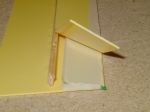
Wedge-Casting:
The ET has some "foam ramps" that have a wedge cross-section. Basic wedge shapes were cast as shown, with styrene sheet plastic built up as molds for casting Alumilite wedges. After curing, the wedges were trimmed to the desired width, and further altered to the desired end shapes by sanding. |
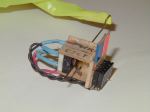
ET Nose Switches #1:
Two lever switches mounted in an assembly so that two small 1/32" pins keep the switches open, until the pins are removed before flight. Shown with one pin in place, holding one of the two switches down. One swithc is from computer power, the other is for arming the ET ejection charges. | 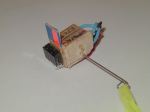
ET Nose Switches #2
View of the other side of the switch assembly. Two small holes are drilled into the ET nose, one above the other, for the Computer power and Ejection Arming switches. | 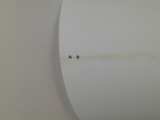
ET Nose Switch holes:
Two holes slightly over 1/16" diameter to allow for the two tubes coming from the ET Nose Switch Assembly. The holes are placed in line with a lengthwise seam, as it is necessary to split the ET nose to get it off of the mold after forming, then glue and splice it back together. The conduits that run down the ET nose are glued over the seam and holes, making the holes almost unnoticeable unless you know to look for them. |
| | | |